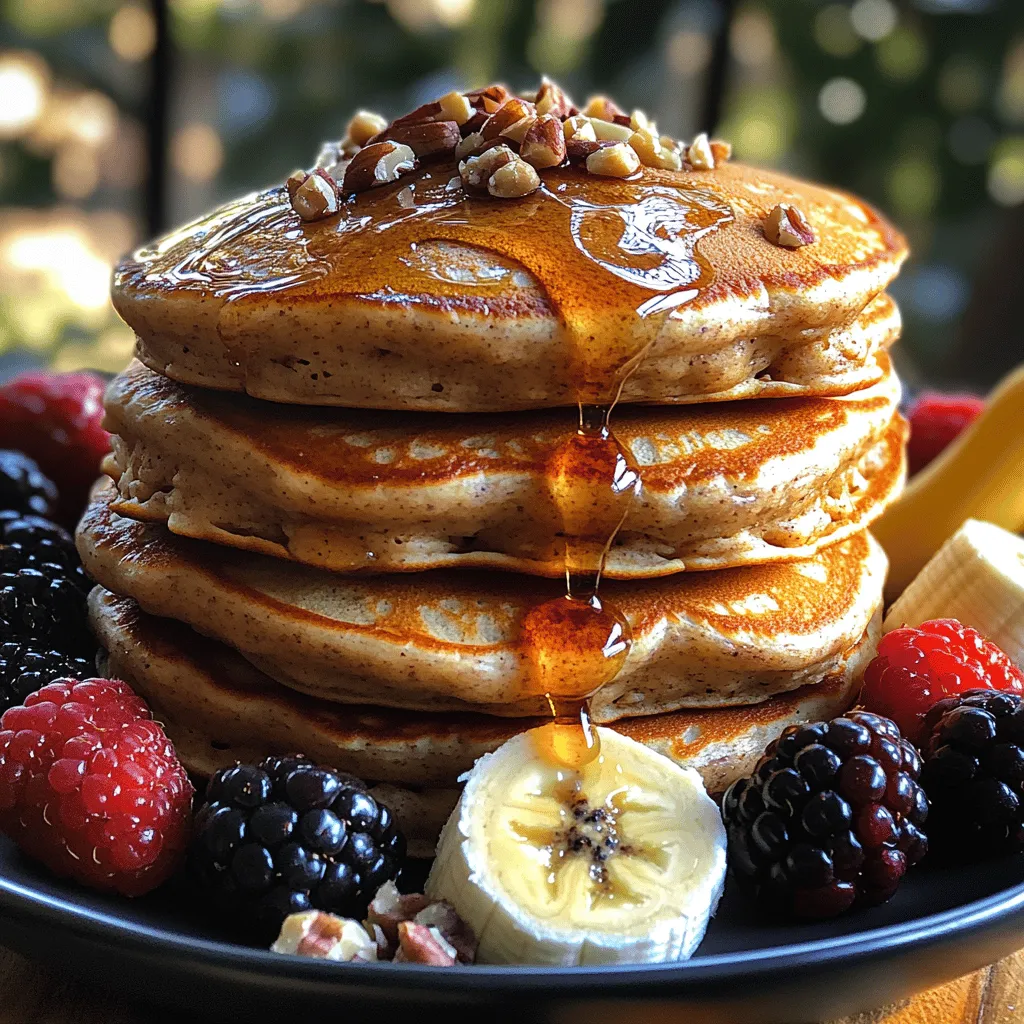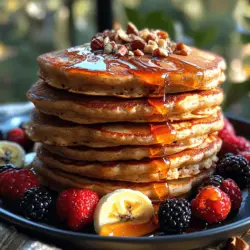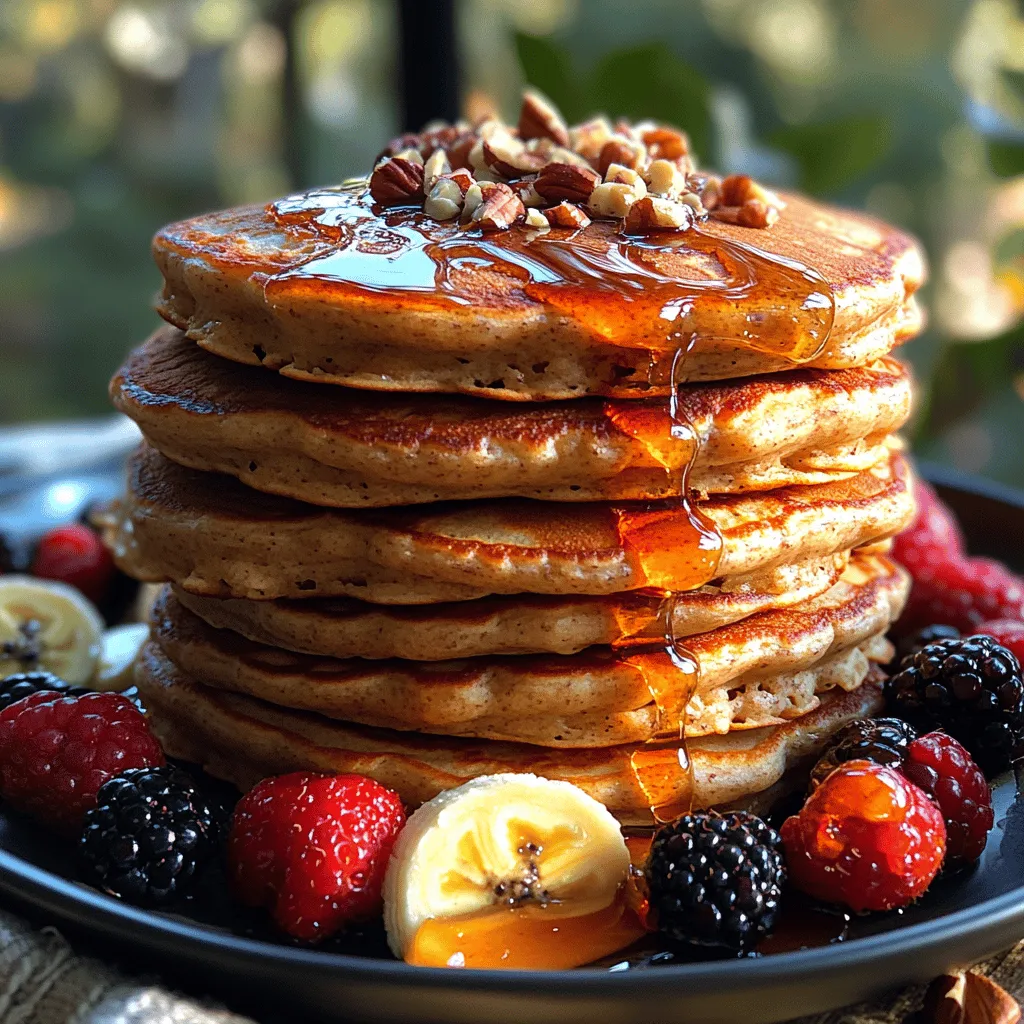Fluffy Almond Flour Pancakes: A Deliciously Healthy Start to Your Day
Pancakes have long held a cherished place in breakfast menus around the world. Their fluffy texture and ability to be dressed up with a variety of toppings make them a universally loved choice for a wholesome morning meal. From classic buttermilk stacks to innovative spins using alternative flours, the pancake has evolved into countless variations. Among these, Fluffy Almond Flour Pancakes stand out not only for their delightful taste but also for their health-conscious ingredients.
In recent years, almond flour has gained popularity as a gluten-free alternative to traditional wheat flour. For those with gluten sensitivities or those simply seeking to incorporate more nutritious options into their diets, almond flour provides a rich, nutty flavor that elevates the pancake experience. Additionally, it is lower in carbohydrates and higher in healthy fats and protein compared to its wheat counterpart, making it an appealing choice for health-conscious individuals.
The benefits of using almond flour extend beyond its nutritional profile. It lends a moist texture to pancakes and allows for a delightful flavor that pairs beautifully with a variety of toppings. Whether you opt for fresh fruits, nut butters, or a drizzle of maple syrup, almond flour pancakes can be customized to suit any palate. In this article, we will delve into the details of creating fluffy almond flour pancakes, exploring both the ingredient breakdown and the essential steps to achieve perfect results.
Understanding Almond Flour
Almond flour is made from finely ground blanched almonds, which are almonds that have had their skins removed. The production process involves grinding the nuts into a fine powder, resulting in a gluten-free flour that is versatile and nutritious. Unlike traditional flour, almond flour retains a significant amount of the almond’s natural oils, contributing to the moist texture of baked goods and pancakes.
Nutritionally, almond flour is a powerhouse. It is rich in healthy fats, particularly monounsaturated fats, which are beneficial for heart health. Additionally, it is a great source of vitamin E, magnesium, and fiber, all of which contribute to overall well-being. When compared to regular flour, almond flour boasts a lower glycemic index, making it a favorable option for those monitoring their blood sugar levels.
In terms of texture and flavor, almond flour brings a unique character to pancakes. Its natural nuttiness enhances the overall taste, while its moisture content helps create that sought-after fluffy texture. The result is a pancake that is not only satisfying but also packed with wholesome goodness.
Ingredients Breakdown
When preparing Fluffy Almond Flour Pancakes, understanding the role of each ingredient is crucial for achieving the perfect pancake.
1. Almond Flour: As the star ingredient, almond flour provides both flavor and nutrition. When sourcing almond flour, look for finely ground options to ensure a smooth batter. You can find almond flour at most grocery stores or online, and it’s often available in both blanched and unblanched varieties. Blanched almond flour is recommended for pancakes, as it yields a lighter texture.
2. Baking Powder and Baking Soda: These leavening agents are essential for achieving fluffy pancakes. Baking powder contains both an acid and a base, allowing it to create carbon dioxide bubbles that help the batter rise. Baking soda, on the other hand, requires an acidic ingredient (such as almond milk or vinegar) to activate its leavening properties. Together, they ensure your pancakes are light and airy.
3. Eggs: Eggs serve as a binding agent in the batter while also adding moisture. They contribute to the overall structure of the pancakes, ensuring they hold together properly. Moreover, eggs enhance the protein content, making the pancakes more filling.
4. Almond Milk: For a dairy-free option, almond milk is a perfect substitute. It adds moisture without overpowering the flavor of the pancakes. If you prefer, other plant-based milks such as oat or coconut milk can also be used.
5. Maple Syrup: As a natural sweetener, maple syrup not only sweetens the batter but also enhances the flavor profile of the pancakes. Opting for pure maple syrup over artificial syrups ensures a more authentic taste and quality.
6. Vanilla Extract: A dash of vanilla extract elevates the flavor of the pancakes, providing a subtle sweetness and warmth that complements the nuttiness of the almond flour.
7. Coconut Oil: This ingredient adds moisture and richness to the pancakes. Coconut oil is known for its health benefits, including its medium-chain fatty acids. If you prefer, unsalted butter can be used as a substitute.
8. Optional Toppings: The versatility of pancakes is one of their greatest attributes. Consider topping your Fluffy Almond Flour Pancakes with a variety of options such as fresh berries, sliced bananas, nut butters, or a dollop of yogurt. Each topping not only adds flavor but also nutritional benefits, enhancing the overall breakfast experience.
Step-by-Step Instructions
Creating Fluffy Almond Flour Pancakes is a straightforward process that begins with the careful mixing of your dry ingredients. Proper mixing is vital to ensure an even texture throughout the pancakes.
Mixing Dry Ingredients: Start by measuring your almond flour accurately, as too much can lead to dense pancakes. Combine almond flour with baking powder and baking soda in a bowl, whisking together to ensure even distribution of the leavening agents.
Combining Wet Ingredients: In a separate bowl, whisk together the eggs, almond milk, maple syrup, vanilla extract, and melted coconut oil. Each of these wet ingredients plays a crucial role in achieving the desired fluffiness. The eggs provide structure and moisture, while the almond milk adds a creamy consistency. Ensure that all wet ingredients are smoothly incorporated to avoid lumps in your batter.
As you prepare to cook your pancakes, remember that the key to fluffiness lies in the proper balance of ingredients and careful mixing. The next phase will focus on cooking techniques that help you achieve the perfect fluffy pancake, ensuring that your Fluffy Almond Flour Pancakes are a delicious breakfast centerpiece.
Stay tuned for the following sections, where we will delve into the cooking process, tips for perfecting your pancakes, and a variety of topping ideas to complete your breakfast experience.

Combining Mixtures
Once you have prepared your dry and wet ingredients separately, it’s time to combine them into a smooth, fluffy batter. Pour the wet mixture into the bowl with the almond flour mixture. Using a spatula or a whisk, gently fold the ingredients together until just combined. Be careful not to over-mix, as this can lead to tough pancakes instead of the light, airy texture we are aiming for.
Technique for Avoiding Over-Mixing
When combining the batter, remember that a few lumps are perfectly fine. Over-mixing develops gluten, which can make your pancakes dense. To avoid this, mix until the dry ingredients are just incorporated. Stop once you see no more dry flour; if you still see a few small lumps, don’t worry—these will cook out as the pancakes cook. The key is to maintain that fluffy texture by being gentle with the batter.
What the Batter Should Look Like for Optimal Results
The ideal pancake batter made with almond flour should be thick but pourable. It should flow smoothly off the spoon without being too runny. If it seems too thick, you can add a splash of milk or water to reach the desired consistency. The batter will also have a slightly grainy texture due to the almond flour, which is normal and adds to the pancakes’ unique character.
Preheating the Pan
Before you start cooking your pancakes, it’s crucial to preheat your pan properly. A non-stick skillet or griddle is ideal for this recipe. Preheat it over medium heat for about 5 minutes. This ensures even cooking and helps prevent sticking.
Importance of Heat Control for Perfect Pancakes
Heat control is vital for achieving perfectly cooked pancakes. If the pan is too hot, the pancakes will burn on the outside while remaining raw in the middle. Conversely, if it’s not hot enough, the pancakes will turn out flat and lack that desirable golden-brown crust. A good rule of thumb is to test the heat by flicking a few drops of water onto the pan; if they sizzle and evaporate quickly, the pan is ready.
Tips for Greasing the Skillet Effectively
To ensure your pancakes don’t stick, lightly grease the skillet before pouring in the batter. You can use a small amount of coconut oil, butter, or a cooking spray. If using butter, let it melt completely and then swirl it around to coat the surface evenly. Remember to reapply the grease between batches to maintain a non-stick surface.
Cooking the Pancakes
Now that your batter is ready and your pan is preheated, it’s time to cook the pancakes. Pour about 1/4 cup of batter onto the skillet for each pancake.
Visual Cues for Knowing When to Flip
Watch for bubbles to form on the surface of the pancake, which indicates that it is cooking properly. Once you see bubbles that don’t pop, it’s time to flip the pancake. Typically, this takes about 2-3 minutes.
Suggested Cooking Times for Perfect Golden Brown Pancakes
After flipping, cook the pancakes for another 1-2 minutes until they are golden brown and cooked through. The pancakes should be light and fluffy with a slightly crisp edge. If you’re making a larger batch, you can keep the cooked pancakes warm in a preheated oven set to 200°F (93°C) while you finish cooking the rest.
Serving Suggestions
Once your pancakes are cooked, it’s time to serve them up! There are endless possibilities for toppings and presentations.
Ideas for Topping Combinations
Classic toppings like maple syrup and fresh berries are always a hit. You can also try almond butter or peanut butter for added protein, along with sliced bananas or a sprinkle of cinnamon for extra flavor. If you want to go decadent, consider whipped cream and chocolate sauce.
Creative Serving Styles for a Visually Appealing Presentation
For an appealing presentation, stack the pancakes high and drizzle them with syrup or a fruit compote. Garnish with fresh mint or a dusting of powdered sugar for a touch of elegance. You could also serve them on a colorful plate or add a side of yogurt for a contrast in textures.
Nutritional Information
Breakdown of the Nutritional Content Per Serving
Each serving of fluffy almond flour pancakes offers a nutritious alternative to traditional pancakes. A typical serving (2-3 pancakes) contains approximately 250-300 calories, 10-12 grams of protein, and 14-16 grams of healthy fats, primarily from the almond flour. This makes them a filling and satisfying breakfast option.
Comparison to Traditional Pancake Recipes
In contrast, traditional pancakes made with all-purpose flour can contain upwards of 400 calories per serving with significantly less protein and higher carbohydrates. Almond flour pancakes are a great choice for those looking to reduce carbs or increase protein intake.
Discussion of Dietary Considerations (Gluten-Free, Low-Carb Options)
These pancakes are naturally gluten-free, making them a suitable option for those with gluten sensitivities or celiac disease. They are also lower in carbohydrates compared to standard pancakes, making them a great choice for those following a low-carb or ketogenic diet.
Creative Variations
Suggestions for Flavor Additions
To customize your pancakes further, consider adding flavor enhancements to the batter. A teaspoon of vanilla extract can add warmth, while a teaspoon of cinnamon or nutmeg can impart a cozy spice flavor. You might also incorporate cocoa powder for a chocolate twist or a handful of chopped nuts for added crunch.
Ideas for Seasonal Variations Using Fruits and Spices
Seasonal ingredients can elevate your pancakes throughout the year. In the fall, try adding pumpkin puree and pumpkin spice for a festive treat. In the summer, incorporate fresh blueberries or chopped strawberries into the batter for a fruity explosion.
Exploring Savory Pancake Options
Don’t be afraid to experiment with savory pancakes as well! Adding ingredients like shredded cheese, herbs, or sautéed vegetables can transform these pancakes into a delightful brunch option. Serve them with a dollop of sour cream or a sprinkle of chives for a gourmet touch.
Storage and Reheating Tips
How to Store Leftover Pancakes Properly
If you have any leftovers, store them in an airtight container in the refrigerator for up to 3 days. For longer storage, you can freeze them. Place parchment paper between the pancakes to prevent sticking and store them in a freezer-safe bag for up to 2 months.
Best Methods for Reheating Pancakes Without Losing Texture
To reheat, simply pop them in the toaster for a few minutes or warm them in a skillet over low heat. If using the microwave, place a damp paper towel over the pancakes to retain moisture and heat for 20-30 seconds. This will help keep them soft and fluffy.
Conclusion
Making fluffy almond flour pancakes is a simple and enjoyable process that yields delicious results. With their light texture and rich flavor, these pancakes are a fantastic gluten-free and low-carb alternative to traditional recipes. Don’t hesitate to explore various toppings, flavor additions, and seasonal variations to make the recipe your own. The joy of homemade pancakes lies in their adaptability to different diets and personal preferences, making breakfast a versatile and delightful meal. So gather your ingredients, fire up the skillet, and enjoy the satisfaction of creating a breakfast masterpiece that everyone will love!

